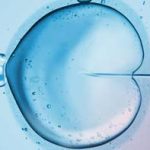IVF
What is IVF?
IVF or in vitro fertilisation is a series of procedures to assist you with conception. It is when a human egg is fertilised with sperm in a laboratory. If the fertilised egg (embryo) successfully implants in the uterus, this will result in pregnancy.
What happens during the IVF process?
IVF is a process, with each IVF cycle occurring with one menstrual cycle.
- Blood test: On day one of your menstrual cycle, you will have a blood test with your fertility clinic.
- Hormone stimulation: On day 2 or 3 of your menstrual cycle, your hormone stimulation treatment will start. You will start taking medicine to stimulate your follicles so they produce several eggs.
- Trigger shot: Once your eggs have reached a certain size, you will give yourself an injection containing hormones that trigger your ovary to mature and release an egg.
- Egg retrieval: About 34 to 36 hours after the trigger shot, your eggs will be retrieved (collected). Your fertility specialist will use a thin needle inserted in your vagina wall into the follicles to retrieve the eggs.
- Semen sample: If you are using your partner’s fresh sperm, they will provide a semen sample on the same day of the egg collection. If this is not possible, a surgical procedure can help extract sperm directly from the testicles. You may also use frozen donor sperm.
- Fertilisation: Healthy sperm and eggs are brought together on a dish and incubated overnight. In some situations, you may need Intra Cytoplasmic Sperm Injection (ICSI), which is a procedure where a single healthy sperm is injected into a mature egg. This may be helpful when the sperm quality is low.
- Embryo transfer: Around 3 to 5 days after egg retrieval, your fertility specialist will transfer an embryo into your uterus. Usually one embryo is transferred, but sometimes more. In some cases your fertility specialist will wait to transfer an embryo. Any good quality embryos that are not transferred might be frozen and used in the future, depending on your individual circumstances.
- Pregnancy test: After the embryo is transferred, you will need to wait 2 weeks before you can test for pregnancy. Blood tests are more reliable than a home pregnancy test, so it’s best to do this at your fertility clinic or through your GP.
Why Iran?
Iran is well-renowned to be the leading destination in the region for fertility treatments. Iranian fertility centers are fully equipped and the specialists are highly-experienced. As the only Muslim country in the world that offers IVF treatment, Iran has definitely pushed ahead with medical research. Couples from the Arabian countries, Turkey, or all the way from Indonesia choose Iran due to the high success rate of the procedure.
IVF Cost in Iran
IVF is an expensive fertility procedure in general. The price of a cycle of IVF depends on many factors, including the fee of the specialist and clinic, medications needed, and the number of embryos you want to get implanted.
Costs also vary depending on the pre-implantation diagnosis (PGD), and post-op care services. Additionally, some couples need egg donation, which increases the overall cost of treatment.
That said, the cost of an IVF procedure in Iran is much more affordable than many other countries. This is because fertility specialists and clinics in Iran charge much more reasonable fees compared with those in other countries — though the cost of medications is not much different.
Typically, the cost of a cycle of IVF in Iran ranges from $3,000 to $5,000, inclusive of medications and all other related costs. This is while a cycle of IVF in the US, for example, would cost around $15,000, which does not include medications. This decent price of IVF in Iran has encouraged many couples who were looking for IVF abroad to travel to Iran to undergo the treatment.
IVF Sex Selection
Sex selection, sometimes incorrectly referred to as gender selection, in IVF is a procedure aimed at assigning an embryo’s sex to help couples have a baby of the sex they like. Some fertility clinics offer sex selection option to IVF candidates but as there are some considerations in this treatment, they also give patients a thorough consultation before the procedure.
There are two sex selection techniques in IVF: using pre-implantation genetic diagnoses (PGD) and microsorting.
PGD sex selection: One of the main methods for sex selection in IVF is PGD. In an IVF cycle, several embryos are produced and then those with the highest quality are selected through pre-implantation genetic diagnoses (PGD) to be transferred to the woman’s uterus. PGD is typically aimed at preventing genetic disorders in babies who are going to be born through IVF but it can be also used to identify the baby’s sex thus creating the chance to implement the embryo with the sex the parents wish.
The success rate of PGD is almost 100%; that is to say, if the IVF is successful and a baby is born, he/she will be of the sex that was decided before.
Microsorting: Another sex selection method in IVF (as well as in IUI) is called microsorting or microsort. In this sperm sorting procedure, extracted sperms are sorted out one by one using a laser flow cytometer based on whether they contain X or Y chromosome. Microsorting is said to have a high success rate for girls (around 90%) and a lower rate for boys (75%).
Artificial sex selection is offered by Iranian hospitals and fertility centers through PGD and microboring, but it is mostly recommended to those who already have children and want to have another child for family balancing.
Sex selection cost in Iran
Sex selection cost varies from country to country and clinic to clinic. The average cost of a PGD in Iran is around $1,000 while Microsorting cost is approximately $700. This is an additional fee and is added to the cost of IVF.
IVF Aftercare
In general, the following instructions are advised for the post-IVF period:
- Do not use the bathtub or swim for 48 hours after embryo transfer
- Avoid vaginal shower or tampon
- Avoid sexual intercourse from a few days before to 2 weeks after embryo transfer
- After embryo transfer, the woman can resume her daily activities. However, avoid intense physical activities such as running, aerobics or playing sports such as football and tennis
- Avoid lifting heavy objects
- Take 24 hours of absolute rest in bed (other than getting up for a bath or having meals).
- Two to three days after the operation, the patient would be able to travel. However, depending on the patient’s situation, some doctors prescribe absolute rest following embryo transfer.














